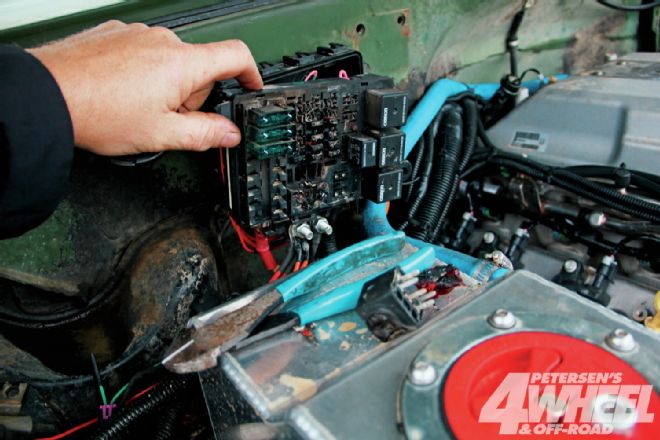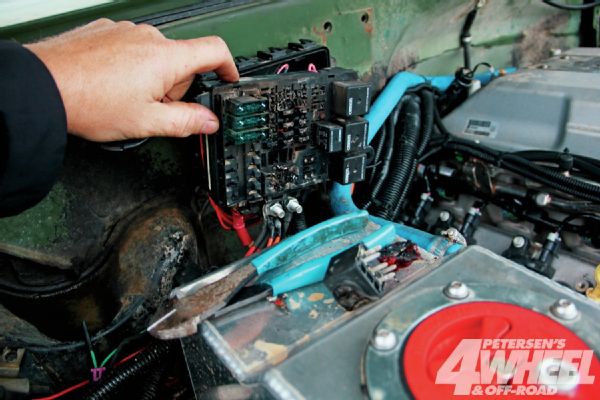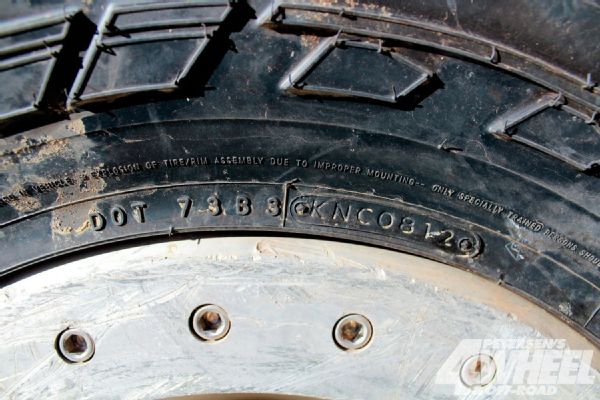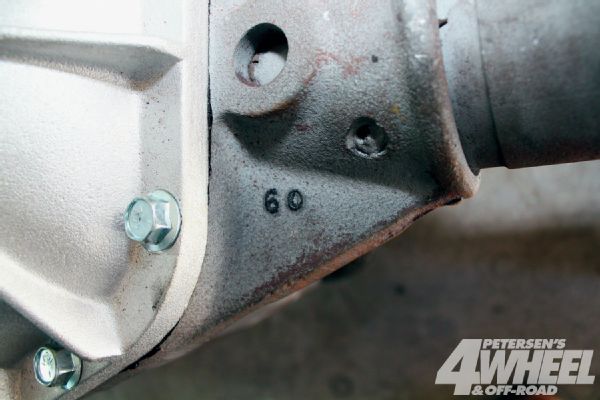
Army Truck Redux
Q: I have to disagree with you concerning Tech Editor Fred Williams’ melted 50-amp fuse (“Meltdown,” Nuts & Bolts, Feb. ’14). You say a high resistance creates heat. Not true. A piece of paper between two contacts would be a high resistance, as would oxidation on a set of points. These are insulators, or perfect resistance to flow of current. I’ve seen plastic wire connectors melted. Is this high resistance? No.
What happens is this: Source voltage is available, load path is good, and at some point the connection becomes compromised (corrosion, connector pins/ spades loosen, and so on). This is not altogether high resistance because there is still a path, but that path is now smaller and being asked to try and continue to carry the original load. This is like trying to run your winch on 16-gauge wire when it requires 1 gauge. A loosened connection is simply a reduced surface area available to flow current, but that same current is demanded and the source is still capable of delivering.
Now, Fred had too many circuits connected to said fuse. All those circuits were fine and simply placed too much load on the target fuse. The fuse did not blow but instead got hot and melted the body. I’d say it was a manufacturer problem with the fuse and the source side of the fuse was well capable of much more current and the load side was certainly drawing enough to melt the fuse. The element was simply made heavier than intended. I’ve only seen that one other time in 25 years as a professional mechanic.
Mike Stephens
via nuts@4wheeloffroad.com

A: Thanks for sharing your thoughts, Mike. You bring up some good points. However, we might have to agree to disagree on a few of your statements. Pieces of paper between electrical contacts or oxidized points are indeed insulators, provided they break an electrical connection completely. But insulators are not examples of “perfect resistance” because in order for resistance to exist in an electrical circuit, there must first be a connection present. If there is no connection, then there is no circuit and therefore no resistance.
Let’s take your corroded points as an example. If they’re corroded to the point that the points no longer make contact with one another, then no current is flowing and the corrosion is acting like an insulator, just like the rubber or plastic that coats a wire. However, if they are just a little corroded and still allow some current to pass through, then the corrosion is acting as a resistor and only allowing some of the current to pass. This resistance to current flow creates heat. It might take a while for heat to build up in a set of points because they open during operation, breaking the connection and allowing the contacts to cool off. But still, have you ever seen a burned-up set of points? Maybe younger guys haven’t, thanks to the modern miracle of electronic ignition, but I’ve seen plenty of them. Like tuning a carburetor, properly setting up points is rapidly becoming a dying art, but I digress.
You are correct in thinking of an electrical circuit like a path, and that the path needs to be big enough to handle the job. I like to think of circuits like a pipeline. If the pipe (or wire gauge and related components in an electrical circuit) is the right diameter for the job, then water (electricity) can flow with no problem and everything is happy. If the pipe is too small in diameter to handle the volume of water (or current) trying to flow through it, then the water starts to back up. The same thing happens if there’s an obstruction placed in the pipe, because water will only flow as much as the smallest section of pipe. It’s the same with electricity. As you say, a poor connection reduces the size of the path for electricity to pass through, so therefore a compromised connection resists the amount of electricity allowed to pass through it. Instead of water backing up with my pipeline analogy, resistance in an electrical circuit causes heat. It’s not a coincidence that a resistor, such as a ballast resistor in our old points ignition system example, can be warm or even hot to the touch.
Why electrical resistance equals heat is more than what we really need to get into here, but since we seem to agree with how a fuse operates (if the amount of current exceeds the rating of the fuse, the “little part” of the fuse heats up and pops), then you must also agree that resistance equals heat. If enough heat builds up, bad things start happening, as it did with Fred’s Army truck. Therefore, regardless of what went wrong, resistance melted the fuse block.
Lastly, you and I agree that Fred had way too many things hooked up to that fuse and that it’s likely that the fuse was bad due to a manufacturing problem, which caused the melted fuse block. Hopefully this helps clear things up.
Old Tires
Q: I’m looking at buying four matching 31x10.50-16.5 tires I found in my local area. The DOT info on them indicates they were made in 1997, but they were never mounted and were stored all that time wrapped in heavy-duty shipping paper. Are these safe? And what price would be reasonable?
Name withheld
via nuts@4wheeloffroad.com

A: 16-year-old tires for street use? I wouldn’t risk it. The biggest enemy of tires is sunlight, but heat is also an issue. Even if they were stored properly, rubber can harden and get brittle with age. Though the seller may claim the tires have been stored in a warehouse and wrapped up, you don’t really have a way of knowing for sure if that has been the case for their entire lives. There is a rule of thumb in the RV and trailer industry that tires should be replaced after seven years whether they are worn out or not because of exposure to sunlight and infrequent use.
If the vehicle the tires are going on is a trail rig or something that gets used around a farm or ranch, and the tires are cheap enough, go for it. But I still wouldn’t bother unless you have some 16.5-inch wheels lying around to mount them on. The 16.5-inch tires are gradually being phased out and it’s really not worth investing in a set of wheels just for some old tires. As for a price, that really depends on what you’re willing to pay, but they would need to be free or close to it if I were going to part with my money for them.
Old School
Q: I have been into 4x4s for years now and have owned several Jeeps. I have gone many different routes in building some of my Jeeps, including big lifts, big motors, and so on.
My latest project is a ’67 Jeepster Commando that now sits in my garage as a pile of parts. As I prepare to rebuild this gem I keep thinking back to my two favorite Jeeps that I had the most fun driving, my ’83 four-cylinder CJ-7 and my ’56 CJ-5. What made them fun is that they were mostly stock(the CJ-7 had a 2-inch lift and 33-inch tires). Both were manual steering with manually operated brakes. There were some bragging rights that came with driving them, especially in the case of the CJ-7, which stalled often (damn electrical gremlins). I decided that instead of going high-dollar custom with the Commando I wanted to revert back to these past vehicles a little. I have Dana 44 front and rear axles with a custom full-floater setup on the rear. I was going to put discs on the rear (I have a Dana 18 with the drum brake). It will have a mild lift with lots of fender cutting, as I have to do that anyway to remove rust. It will run a fairly stock V-6. I have already removed the stock steering on it, and the front Dana 44 is set up for crossover steering.
What would be a good manual steering box and brake setup? And what would a good tire size to run with this setup? I did 33s before, and I don’t remember it being totally awful, but I was a lot younger then. Any advice would be greatly appreciated.
Matt
via nuts@4wheeloffroad.com
A: Old-school 4-wheeling! Though I really like my rockcrawling buggy (tube-car according to Fred Williams), I have just as much fun and sometimes more wheeling my little ’84 four-cylinder CJ-7 with a 2-inch lift and 31s. It has manual steering and brakes, and manhandling it up hills while fighting the carburetor is awesome in a sick and twisted way. Like you, this Jeep brings back fond memories of past no-frills Jeeps I’ve owned in equally dubious mechanical condition.
I’ll answer your last question first, since it will have an impact on the rest of what you do. The low-lift big-tire look is a popular trend right now and it has a lot of advantages. Determining what tire to run depends a lot on how you intend to use the Jeep. If you want to build a mild recreational wheeler, then just about any tire size will do. If you want to go rockcrawling, then go bigger. If you want to go mudding, go bigger still. I would recommend sticking with a conservative amount of lift, determine a tire size you want, and then trim sheetmetal as necessary. With your Jeep’s mild V-6 and Dana 44s, it should be able to handle 35s with no problem and maybe 37s with a light foot and chromoly shafts.
In terms of the steering, I can tell you firsthand that memories of past Jeeps are sometimes better than they were in reality. Just one trail ride with my new-to-me manual steering CJ-7 had me gathering parts to do a power steering conversion. I’m probably just getting old and lazy, but the novelty of having to muscle the steering wheel when trying to pilot the Jeep through obstacles wore off quickly, especially when trying to keep the thing running and have enough momentum to avoid killing the tired four-banger. It depends on how much of a purist you want to be, but manual steering with 33-inch or larger tires will definitely give you a workout, and 37s with manual steering sounds like torture!
Whatever you do, cut off the tractor steering that came on the Commando and convert to a manual or power Saginaw steering box, which can easily be adapted to your crossover steering setup and can be readily sourced from other Jeep models as well as a variety of GM car and truck applications.
Going with manual brakes, on the other hand, is not a terrible idea. If the system is set up properly you won’t need a linebacker’s left leg to bring the Jeep to a stop, and you’ll have the bonus of normal brakes for more than two pumps with the engine off. Considering your custom application and rear disc swap, it’s going to be critical that you do the math and select a master cylinder with the proper bore and volume to work effectively with the disc brakes that you use. There have been several good brake stories printed in this magazine over the years that can help guide you, and you can find even more information on www.4wheeloffroad.com.
Keep in mind, however, that larger tires place more leverage on brake systems, so the taller the tire, the more likely you will appreciate having some power assisted brakes. Power brakes might also be a better option if you intend to have others behind the wheel who are not familiar with manual brakes. If you decide to go with power brakes, don’t overlook hydroboost as an option, as those systems can be very effective and have a smaller footprint than a vacuum booster.
As for an ideal source vehicle, that all depends on how the math works out for the calipers and master cylinder you need. Brake boosters and master cylinders are more interchangeable than you might think.
Dana 60 ID
Q: I own an ’11 Ford F-350 diesel 4x4 and am wondering which front axle the truck has, exactly. I’ve been told by many that it’s a Dana 60 high pinion or a Dana Super 60. I’m looking to get a Lock-Right for the front to improve traction. Any input would be greatly appreciated.
Name withheld
via nuts@4wheeloffroad.com

A: You have been told correctly: Your truck has a high-pinion (also known as reverse rotation) Dana 60 equipped with ball joint knuckles and unit bearings. For further verification, look on the ribbing around the differential centersection; there is usually (but not always) a telltale “60” cast somewhere on the ribbing. It’s a great axle and well known to be able to stand up to serious abuse. The Dana Super 60 was used in the heavier F-450 and F-550 trucks only. Your axle should have 35-spline inner axleshafts, and the Lock-Right part number is 92-0460-3200. A Lock-Right is an affordable “lunchbox locker” that uses the factory carrier, so there’s no need to reshim the ring-and-pinion when installing it. I’ve had very good luck with Lock-Rights over the years and wouldn’t hesitate to recommend one to someone on a budget.
You didn’t mention how you’re using the truck, but it seems like an unlikely rockcrawling candidate. Keep in mind a front locker is going to drastically change how the truck steers in 4WD, but it’s hard to beat the added traction. If that’s a concern for you, then a limited-slip might be a better choice.
JK Pinging
Q: I have an ’08 Jeep Unlimited, 3.8L with a six-speed transmission. The Jeep has a pinging issue I can’t seem to fix. I bought it used and it has 100,000 miles on it, and it has been pinging from the day I got the keys. I did a complete tune-up, EGR valve, knock sensor, and all four O2 sensors. Even with a scanner it shows no problems. I have tried Seafoam for carbon removal but no difference. The engine runs great with no pinging when it’s cold, but once up to operating temperature it pings like crazy. Any thoughts on what could be causing this? Any advice would be greatly appreciated, thank you.
Tim Campbell
via nuts@4wheeloffroad.com
A: You’re not the first one to write in with this question. The 3.8L engine used in ’07-’11 JKs has a checkered reputation, to put it politely, especially the ’07-’08 models. Since you have already covered the usual suspects, we turned to someone who deals with JKs on a day-to-day basis for more potential things to check.
Larie Tales at Jeeps R Us (www.jeepsrus.com, 949/497-9183) said the pinging complaint is relatively rare for the 3.8L, but he recommended checking the fuel pressure. The stock specification is 58 psi, plus or minus 2 psi. If it’s a little below specifications, that could be causing the problem without triggering a check engine light. Unfortunately, the fuel pump and fuel pressure regulator are one unit located in the tank and servicing either of them amounts to replacing the fuel pump assembly, which is a bit pricey. He also noted that the ’07-’08 models were notable for engine failures in as few as 50,000-60,000 miles, but it would seem logical that if yours has made it to 100,000, then it’s not one of the problem children. Tales also noted to try different fuel brands and octane levels to see if that helped, but if you’ve already gone as far as you have, he and I both figured you’ve probably tried that already.
One other thing to keep in mind is that modern engines have extremely sophisticated monitoring systems that don’t hesitate to throw that tattletale check engine light and its related code at the first sign of trouble. If it’s not throwing codes, you may be hearing something else, like a noisy lifter or an exhaust leak or any number of other things. Different engine in a different vehicle, but case in point: My wife and I bought a Liberty brand new in 2002 (hey, it was my wife’s car, not mine). I took it back to the dealer three different times because it had been pinging since we drove it off the lot. They gave it the once-over all three times and basically told me the same thing: If there was a problem, it would be throwing codes. I could swear it was pinging, and since it had a 100,000-mile powertrain warranty and my complaints had been well documented, I figured I would just wait until it melted down. Then I would bring it to them on a hook along with the associated “I told you so” comments. That day never came. Even though I swear to this day that the Jeep pinged like crazy, especially under load, it recently found a new home with over 148,000 miles on the ticker and never had a single ping-related issue.
Nuts, I’m Confused
Mileage Master
Q: In this current situation where gas mileage is a big concern, I’ve been wondering if there is a way to find out how much power a certain axle or transfer case wastes doing its duty. Case in point, I’m restifying a ’78 F-250 Crew Cab as a daily driver/tow rig, and I need to replace or upgrade the Dana 60 rearend because it’s shot. I am considering four choices: a Dana 70, a 14-bolt, a Sterling 101⁄4, or a Sterling 101 ⁄2. Which one is most efficient? I know I would never recoup the cost of changing a rear axle out just to get a fraction of a percent in improvement, but since I’m swapping it out anyway, I’d rather put the most efficient axle back in.
I’m going to run a 300ci inline-six, which is not a real powerhouse, but I definitely have different torque requirements than a new diesel truck. Is loss always a fixed percentage, or does it change according to input horsepower? I know you had an article a while back that showed all the maximum and continuous torque load ratings of different transfer cases, but I’d love to see one that listed horsepower loss in axles, transfer cases, and transmissions. I have to believe this is something automotive engineers consider and factor into new vehicles.
Philip Swayze
via nuts@4wheeloffroad.com
A: Interesting questions, Philip, but unfortunately the answers you seek aren’t readily available. It is true that each portion of the drivetrain represents a parasitic loss, and that this loss varies depending on the component. Specific to axles, however, we’d be willing to bet they’re all pretty much the same in regards to parasitic loss because they all do essentially the same thing and use the same components to do their job the same way, namely transferring power via a ring-and-pinion, a carrier, and axleshafts. There is probably a small measurable difference between a semifloating axle (like a Ford 9-inch) and a full-floater (like a Dana 70) due to the increased size of the components in the heavier-duty axle and the difference in design, but the real-world implications are negligible. I say “probably” because there’s very little information like what you are requesting out there. Even our fellow drag-racing gearheads that obsess over tenths and are looking for every advantage they can find have had questionable results going from one axle to another.
The bigger factor to consider here is the weight of the components. Though there might be a tiny difference in parasitic loss between two axles, what is going to make a bigger difference is the amount of weight each one represents. All of the rear axles you mention are used under 3⁄4- or 1-ton trucks, so they’re all pretty beefy and come with a significant amount of weight to match. It takes power to make that weight move, and the heavier the weight, the more power you are going to need to get things moving. If you’re looking to build a mileage master, I would take into account parasitic loss to a certain extent, but I would mostly place an emphasis on reducing weight.
A manual tranny is proven to introduce less parasitic loss than an automatic, so that’s a natural choice. A manual with overdrive is also a good idea. As a rule, newer components that have been designed and built in an age where mileage is a concern are going to be more efficient than older technology. Therefore, it would seem reasonable to assume that a modern chain-drive transfer case will introduce less parasitic loss than the tried and true gear-driven NP205 that’s probably in your truck. At the same time, it is highly doubtful the advantages in efficiency would justify the cost of swapping them, not to mention potentially reducing strength.
Weight and final drive ratio have a huge impact on performance and fuel efficiency, so putting your truck on a diet will net real-world gains in fuel economy. Things like fiberglass front fenders and ditching the bed-mounted toolbox full of tools can have a real impact on mileage.
I would also give careful consideration to axle gear ratio. The 300ci inline-six is a great engine, but it’s going to need a pretty deep axle gear ratio if you intend to put a load behind the truck, and that’s going to hurt fuel economy. If the truck is mostly a daily driver, then consider going with a higher (numerically lower) gear. But this will sacrifice hauling capability. And if you’re not going to be hauling a whole lot of weight, is a full-floating axle like the ones you listed really necessary, or would a lighter 1⁄2-ton axle (like a Ford 9-inch) do the job? Building a truck is often a game of compromises, so focus on the things you want the finished product to do, prioritize those things that impact one priority at the expense of another, and work backwards from there.
Submission Information
Confused? Email your questions about trucks, 4x4s, and off-roading tech using “Nuts, I’m confused” as the subject and include a picture (if it’s applicable). Digital photos must measure no less than 1600 x 1200 pixels (or two megapixels) and be saved as a TIFF, an EPS, or a maximum-quality JPEG file. Also, I’ll be checking the forums on our website (www.4wheeloffroad.com), and if I see a question that I think more of you might want to have answered, I’ll print that as well. Otherwise drop it old-school style with the envelope addressed to the address below. Letters published in this magazine reflect the opinions of the writers, and we reserve the right to edit letters for clarity, brevity, or other purposes. Write to: Nuts & Bolts, 4-Wheel & Off-Road, 831 S. Douglas St., El Segundo, CA 90245 fax to: 818.566.8501 Email to: nuts@4wheeloffroad.com